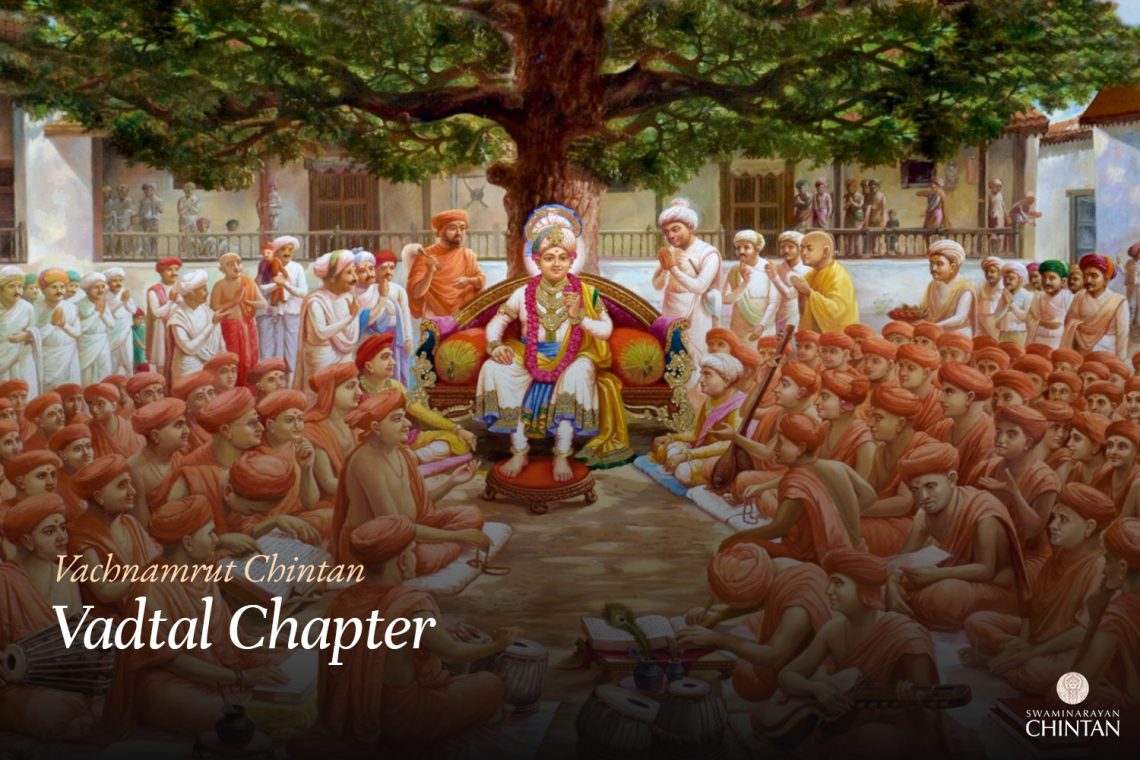Central Insights:
- The underlying factors leading to daivi (divine) and asuri (demonic) nature.
Key Points:
- Souls with divine or demonic tendencies have existed since the beginningless time.
- A soul attains a particular state based on its karma (actions).
- A soul acquires tendencies similar to those with whom it associates.
- A soul becomes divine through the blessings of a Satpurush (true saint) and demonic through their displeasure.
Explanation:
In this Vachanamrut, Shobharam Shastri posed a question to Maharaj: “Maharaj, are the two types of souls—divine and demonic—eternal, or have they come to be as a result of certain circumstances?”
Maharaj replied, “In this universe, there exist two types of souls—daivi and asuri. In alignment with the Gita verse, द्वौ भूतसर्गौ लोकेऽस्मिन् दैव आसुर एव च — (Dvau bhūtasargau loke’smin daiva āsura eva ca) means that In this world, there are two types of created beings: the divine and the demonic, some souls are inherently sattvic (pure by nature), inclined to live righteously, worship deities, develop love for Paramatma (God), and engage in navadha bhakti (nine forms of devotion). Such souls perform virtuous deeds and maintain control over their senses and antahkaran (inner faculties). These are classified as daivi souls. Conversely, some souls oppose God and His devotees without reason, indulge in intoxication and violence, cause distress to others, and are dominated by tamasic (dark and ignorant) tendencies, pride, and arrogance. These are termed as asuri souls.
Maharaj further explains whether these two types of souls have existed eternally or have been shaped by circumstances. He says that some souls inherently possess divine or demonic dispositions from the beginning of creation. Other souls, however, acquire divine or demonic tendencies based on their associations after entering the universe. In other words, good or bad company serves as a catalyst in shaping one’s nature. Additionally, some souls develop these traits over time through their actions—good deeds leading to divine qualities and the desire for liberation, while negative actions lead them toward demonic traits. Thus, their own actions are the primary cause of their divine or demonic disposition.
Moreover, Maharaj asserts that the primary cause of divine or demonic qualities is the blessing or displeasure of a Satpurush. The key characteristic or identifier of daivi and asuri nature is one’s attitude toward God’s true devotees. Love for God’s devotees is the hallmark of daivi nature, while enmity towards them defines asuri nature. Maharaj illustrates this by recounting the story of Jay and Vijay, the divine attendants of Bhagwan, who attained asuri qualities due to their hostility towards the sages such as Sanak and his companions.
Here, there is an important subtlety. Jay and Vijay were attendants in Bhagwan’s court and did not directly oppose God or express overt hostility. However, their enmity towards the Satpurush sages led them to acquire asuri tendencies, despite the presence of Bhagwan and other virtuous beings. Conversely, Prahlad, although born among demons, embraced the guidance of Naradji and, despite adverse circumstances, attained a state of param bhagwat (exalted devotion to God).
Maharaj concludes that the primary catalyst for becoming divine or demonic lies in the blessing or wrath of a Satpurush. Likewise, the primary mark of a daivi soul is their affection for God’s devotees, while the core characteristic of an asuri soul is enmity or hostility towards the Satpurush. Therefore, Maharaj advises, “A soul upon whom the great saint’s wrath falls becomes demonic, whereas one who earns the saint’s pleasure becomes divine. There is no other cause for becoming divine or demonic. Anyone desiring their welfare should avoid opposing God and His devotees and should strive to earn their blessings.”
Glossary
| Daivi – Divine nature |
| Asuri – Demonic nature |
| Satpurush – A true saint or spiritual guide |
| Antahkaran – Inner faculties The mind, intellect, consciousness, and ego, which help in acquiring spiritual knowledge. |
| Navadha Bhakti – Nine forms of devotion The different ways of expressing devotion to Bhagwan, such as Kirtan, Katha, and Mansi Puja. |
| Tamasic – Dark and ignorant nature |
| Sattvic – Pure nature |
| Anvay-Vyatirek – Pervasiveness and Distinctness The concept of God being present everywhere (Anvay) yet distinct and unaffected (Vyatirek) from creation and Maya. |

